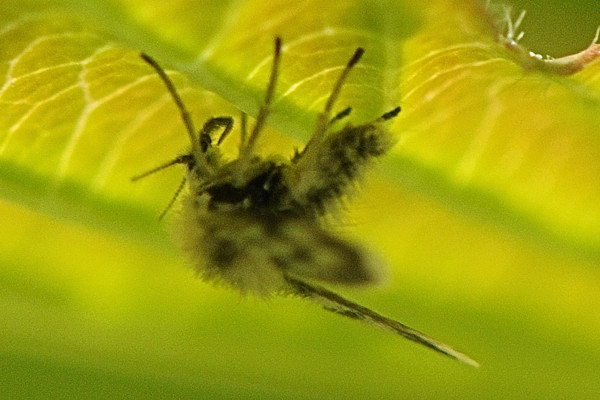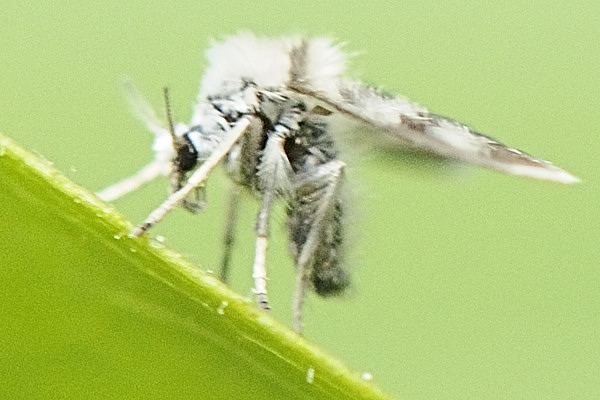Diptera.info :: Identification queries :: Diptera (adults)
Page 1 of 2: 12
|
|
Psychodidae Moth-fly/Owlet-midge
|
|
| nick upton |
Posted on 06-05-2010 13:13
|
|
Member Location: Wiltshire, UK Posts: 828 Joined: 12.03.10 |
I finally got some half decent photos of these tiny 3-4mm mothlike flies, which normally lurk in the shadows in my garden, as one was sitting in cool evening sunshine yesterday. I'm sure this is a difficult family, but can anyone help identify it at least to genus? I was surprised to find it appears to have sucking mouthparts in the third not very good shot, as mouthparts are meant to be non functional in most genera according to the Dipterists forum except in females of the Sycoracinae, which feed on amphibian blood, and the human blood feeding Phlebotominae or “sand flies” (an awful tropical curse that spread spreading leishmaniasis), but it doesn't look like a sandfly and I can't find any good images of Sycoracinae and am not sure these subfamilies are found in the UK. Maybe the mouthparts in the species i photographed are non-functional despite their size. Wiltshire, southwest UK 5.5.10 nick upton attached the following image:  [141.84Kb] Nick Upton - naturalist and photographer |
|
|
|
| nick upton |
Posted on 06-05-2010 13:14
|
|
Member Location: Wiltshire, UK Posts: 828 Joined: 12.03.10 |
With wings raised showing abdomen and legs
nick upton attached the following image:  [131.18Kb] Nick Upton - naturalist and photographer |
|
|
|
| nick upton |
Posted on 06-05-2010 13:15
|
|
Member Location: Wiltshire, UK Posts: 828 Joined: 12.03.10 |
And with ? sucking? mouthparts. No clearer photos of these yet...
nick upton attached the following image:  [117.53Kb] Nick Upton - naturalist and photographer |
|
|
|
| Gunnar M Kvifte |
Posted on 06-05-2010 18:11
|
|
Member Location: Kassel, Germany Posts: 436 Joined: 18.08.09 |
This is not a Sycoracine, as the wing has a 5-branched r rather than a 4-branched one (that is, two veins between the main forks). The mouthparts in the picture are palps, which are present in most (all?) genera of Psychodidae. The Sycoracine genus Sycorax is found in the UK, represented by two species (according to Withers (1989), please let me know if there has been more records since then). In Norway I have found the species Sycorax silacea near shallow streams in early summer, in deciduous forests. It is never very common, though. To me, your pictures look like Clytocerus based on the dark spotted wings and the long scapus. Withers, P. 1989. Moth flies - Diptera: Psychodidae. Dipterists Digest 4: 1-83 Edited by Gunnar M Kvifte on 06-05-2010 18:26 |
|
|
|
| nick upton |
Posted on 06-05-2010 18:16
|
|
Member Location: Wiltshire, UK Posts: 828 Joined: 12.03.10 |
Many thanks Gunnar for this expert feedback - very helpful.
Nick Upton - naturalist and photographer |
|
|
|
| phil withers |
Posted on 06-05-2010 23:07
|
|
Member Location: Lyon, France Posts: 521 Joined: 04.03.08 |
How much water is there in your garden ? Gunnar may be right, but Clytocerus is rarely found far from damp habitats (although it is very common and very resistant to pollutants). Sycorax (there are 3 British species now, one only in Ireland - so far !) are much smaller and paler with no contrasting dark scales: they are closely associated with tufa formations. I'm not going to commit myself to this actually being a Clytocerus: I don't do them with scales on ! It might equally be a Pericoma - the scape is not that long. |
|
|
|
| nick upton |
Posted on 07-05-2010 08:16
|
|
Member Location: Wiltshire, UK Posts: 828 Joined: 12.03.10 |
We have a large water butt a few yards from the hedgerow the psychodids lurk in, but maybe more importantly one of our neighbours has a large, sloping garden adjoining ours with about 5 ponds on different levels. I've always thought that his ponds increase the diversity of insects in our garden and we often see dragonflies and other damp/aquatic associated species. Does that info push the ID more towards Clytocerus? Are there any other camera angles that would help with ID? It is a fight to get enough light to get much focus depth, and i don't use flash, but I can try!
Nick Upton - naturalist and photographer |
|
|
|
| phil withers |
Posted on 07-05-2010 15:46
|
|
Member Location: Lyon, France Posts: 521 Joined: 04.03.08 |
I doubt you'll get what is needed - a clear shot of the antenna of a male: if it is Clytocerus, this will have a wavy brush of hairs on the basal segment (easy to see on a slide, less so in nature !). If you're feeling strong, give it a go, or slap it into alcohol and I'll identify it from here. The situation you describe would certainly not rule out a number of possibilities...pity they're such tiny buggers ! Still, no-one said being a dipterist was supposed to be easy... |
|
|
|
| nick upton |
Posted on 07-05-2010 16:43
|
|
Member Location: Wiltshire, UK Posts: 828 Joined: 12.03.10 |
OK, I'll take up the challenge and see if I can get any clear antennae shots. Will be tricky: they're tiny, keep their heads down and hate bright light, but there are more than ever around at the mo.. so I should have a few chances before alcohol is needed.
Nick Upton - naturalist and photographer |
|
|
|
| nick upton |
Posted on 10-05-2010 22:56
|
|
Member Location: Wiltshire, UK Posts: 828 Joined: 12.03.10 |
I got some not very good antennae shots. I can see some brushlike hairs at the base of the antennae on my originals, but they're at the edge of resolution.
nick upton attached the following image:  [120.68Kb] Nick Upton - naturalist and photographer |
|
|
|
| nick upton |
Posted on 10-05-2010 22:57
|
|
Member Location: Wiltshire, UK Posts: 828 Joined: 12.03.10 |
take 2:
nick upton attached the following image:  [127.01Kb] Nick Upton - naturalist and photographer |
|
|
|
| phil withers |
Posted on 11-05-2010 10:49
|
|
Member Location: Lyon, France Posts: 521 Joined: 04.03.08 |
Nice try: still not sure, but I tend towards a Pericoma. By the way, I would very much like to use your first photo as the cover of the revised mothfly handbook, if you're agreeable. Nice shot ! |
|
|
|
| nick upton |
Posted on 11-05-2010 11:17
|
|
Member Location: Wiltshire, UK Posts: 828 Joined: 12.03.10 |
OK, thanks Phil. Basically, could do better on the antennae photography front.. May have to get that extension tube after all... As for using the first photo on the handbook, I'm sure that's possible. I'll write directly re what format/ frame size, how to send etc and maybe you really do need a few in alcohol to be sure what we're looking at.
Nick Upton - naturalist and photographer |
|
|
|
| nick upton |
Posted on 15-05-2010 22:25
|
|
Member Location: Wiltshire, UK Posts: 828 Joined: 12.03.10 |
IS this much darker specimen necessarily a different species, or can the colours vary a lot within a species? Same Wiltshire garden Location 14.5.10 nick upton attached the following image:  [136.21Kb] Nick Upton - naturalist and photographer |
|
|
|
| phil withers |
Posted on 15-05-2010 23:38
|
|
Member Location: Lyon, France Posts: 521 Joined: 04.03.08 |
No, this is something different: same procedure as before ! After immortalising it in glorious colour, send it to me an we will give it an appropriate send-off... |
|
|
|
| nick upton |
Posted on 16-05-2010 11:02
|
|
Member Location: Wiltshire, UK Posts: 828 Joined: 12.03.10 |
OK, will do my best to find some more dark ones.
Nick Upton - naturalist and photographer |
|
|
|
| nick upton |
Posted on 08-06-2010 21:14
|
|
Member Location: Wiltshire, UK Posts: 828 Joined: 12.03.10 |
Definitive IDs now through from Phil Withers based on specimens: The first, pale species (several images) in this thread is Pericoma blandula The final, dark species (one image) is Boreoclytocerus dalii Many thanks Phil. Will keep looking for more in case further species appear later in the year. Nick Upton - naturalist and photographer |
|
|
|
| weia |
Posted on 26-02-2017 20:01
|
|
Member Location: Posts: 435 Joined: 10.07.11 |
I doubt the ID of the dark one on post #14 See http://www.diptera.info/forum/viewthread.php?forum_id=25&thread_id=78165&pid=327196#post_327196
Edited by weia on 26-02-2017 20:02 |
|
|
|
| nick upton |
Posted on 17-03-2017 18:04
|
|
Member Location: Wiltshire, UK Posts: 828 Joined: 12.03.10 |
The darker fly in post no 14 was identified from a specimen by Phil Withers (who has written a key for this family) as Boreoclytocerus dalii, the paler one in earlier posts as Pericoma blandula. I am no expert on this family but will follow Phil's ID unless a good reason to doubt it is provided!
Nick Upton - naturalist and photographer |
|
|
|
| weia |
Posted on 14-06-2018 12:22
|
|
Member Location: Posts: 435 Joined: 10.07.11 |
The dark one of post #14 is definitely not a (Breo)Clytocerus. Pneumia spec. maybe. |
|
|
|
Page 1 of 2: 12
| Jump to Forum: |












